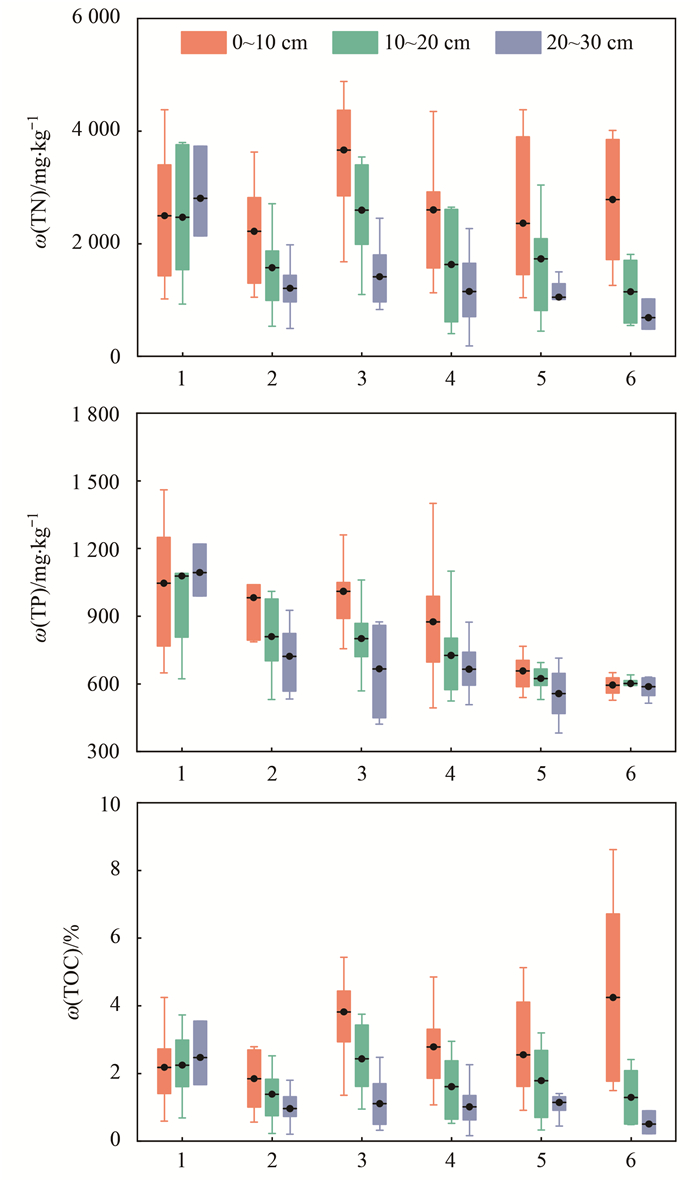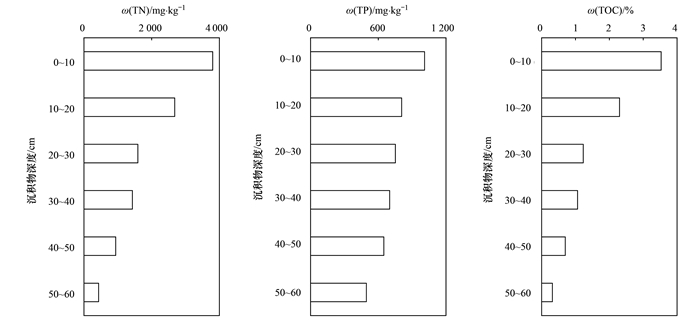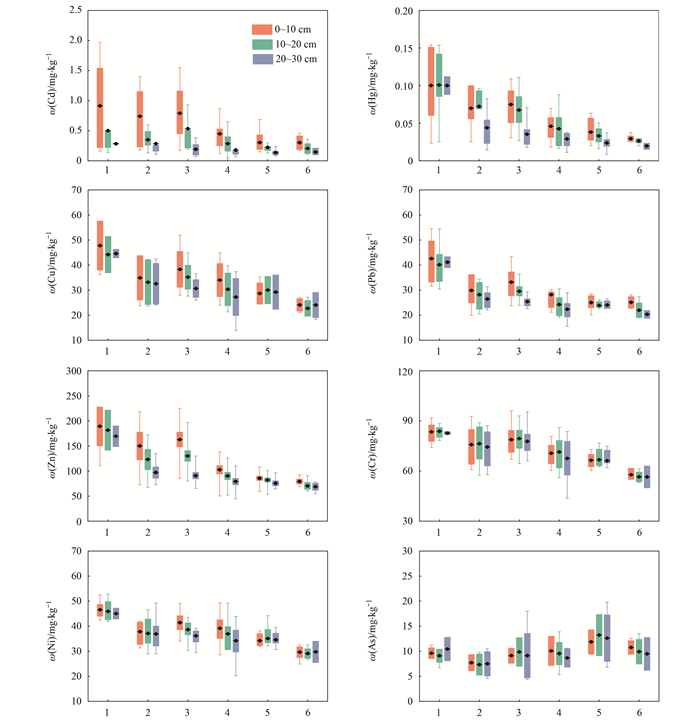2. 中国科学院生态环境研究中心环境水质学国家重点实验室, 北京 100085;
3. 河北大学生命科学学院生态与环境治理研究所, 保定 071002
2. State Key Laboratory of Environmental Aquatic Chemistry, Research Center for Eco-Environmental Sciences, Chinese Academy of Sciences, Beijing 100085, China;
3. Institute of Ecology and Environmental Governance, College of Life Sciences, Hebei University, Baoding 071002, China
湖泊沉积物是营养盐和重金属等污染物重要的蓄积库, 既可以充当污染物的“汇”, 也可以充当污染物的“源”[1~3]. 外源污染物进入湖泊初期, 通过沉淀等方式蓄积在沉积物中; 在适当条件下, 沉积物会向上覆水中释放污染物, 恶化湖泊水质, 威胁湖泊生态环境[4~6]. 意大利的Lake Trasimeno沉积物中重金属向水体释放, 影响水生生物生活, 进而引发生态环境问题[7]. 在我国, 巢湖、滇池和洞庭湖等湖泊沉积物释放大量营养盐, 水体富营养化严重, 水质恶化[8~10]. 因此, 在外源输入得到一定程度控制的同时, 沉积物内源释放问题便成为湖泊水生态系统治理过程中迫切需要解决的问题[11, 12].
白洋淀位于河北省中部, 是华北平原最大的草型浅水湖泊, 是正在建设的雄安新区的中心, 为新区社会经济发展提供了重要的生态服务功能. 但过去几十年中, 随着上游流域经济社会的发展, 工业废水和生活污水排放以及淀内水产养殖逐渐增多, 使白洋淀生态环境质量下降[13~15]. 近年来, 尽管通过减少外源输入负荷, 白洋淀的水质有一定程度改善, 但沉积物内源污染依然存在[16, 17]. 为了满足新区建设对水质的高要求, 需要进一步提升水质和全面恢复水生态.
目前, 相关学者对白洋淀水体富营养化和沉积物污染特征进行了研究[18~23], 结果表明府河对白洋淀影响最大. 但鲜见根据不同生境和不同水质状况对府河入淀影响范围进行分区, 采集柱状样品, 同时关注沉积物中营养盐和重金属, 进而详细比较府河入淀影响区沉积物污染空间差异. 因此本文重点研究白洋淀府河影响区, 根据府河入淀水流的扩散, 将府河影响区分为6个片区, 分层采集沉积物样品, 测定并研究沉积物中总氮(TN)、总磷(TP)、总有机碳(TOC)和重金属(Cd、Hg、Cu、Pb、Zn、Cr、Ni和As)的污染特征及风险, 以期为府河影响区内源污染防治及清淤提供科学依据.
1 材料与方法 1.1 研究区概况及样品采集白洋淀地处华北平原中部, 地理坐标为115°38′~116°07′E、38°43′~39°02′N, 四周以堤坝为界, 淀区地势自西北向东南倾斜, 有府河和唐河等8条河流流入淀区, 赵王新河作为出水口. 目前除府河外, 其余入淀河流已基本季节性断流[24]. 近几十年白洋淀上游社会经济发展较快, 保定市生活污水和工业废水主要通过府河进入白洋淀, 长期的外源污染输入和沉积, 使得府河入淀区域沉积物污染严重, 且污染有随水流向出水口方向蔓延的趋势[25].
为了明确白洋淀府河影响区沉积物污染的空间分布, 根据府河入淀水流的扩散、水质以及生境将研究区域分为6个片区(图 1). 于2020年10月在该区域进行现场沉积物样品采集, 利用手持GPS定位设置48个采样点, 采样点具体信息及分布见表 1和图 1. 用内径8.5 cm柱状采样器采集沉积柱, 现场以10 cm间隔进行分层.
|
|
表 1 白洋淀府河影响区积物采样点具体信息 Table 1 Specific information of sediment sampling sites in the Fuhe River influenced area of Baiyangdian Lake |

|
图 1 白洋淀府河影响区沉积物采样点分布示意 Fig. 1 Distribution of sediment sampling sites in the Fuhe River influenced area of Baiyangdian Lake |
样品放入-20℃冰箱冷冻后进行冷冻干燥处理, 研磨过100目筛装入密封袋中, 处理后的样品贮存于-20℃冰箱中备用.
沉积物中TN采用K1100全自动凯氏定氮仪(SYS-S115)测量; TP采用HCl-HNO3-HF-HClO4联合消解, 使用ICP-OES测定; TOC采用重铬酸钾容量法测量; 沉积物中重金属测定参照文献[26], Cd、Cu、Pb、Zn、Cr、Ni和As使用电感耦合等离子体质谱仪(SYS-S100)测定, Hg使用AFS-820型双道原子荧光光度计(SYS-S099)测定.
另选取府河入淀、府河-南刘庄和南刘庄片区6个样点(3、6、11、16、19和21)表层沉积物样品测试重金属(Cd、Hg、Cu、Pb、Zn、Cr、Ni和As)浸出毒性, 重金属浸出毒性采用硫酸硝酸法对沉积物进行浸提[27], 浸出液中的重金属浓度测定方法同上.
1.3 沉积物污染评价方法沉积物中TOC和TN采用有机污染指数法进行评价, TP采用单因子指数法进行评价, 计算公式分别为[3]:

|
式中, I0为有机污染指数, WTOC和WTN分别为TOC和TN的含量(%), Si为TP污染指数; Ci为TP的含量(mg·kg-1), Cs为区域沉积物中TP的标准值, 本文采用引起最低级别生态风险效应的TP阈值(600 mg·kg-1)[28]. I0和Si的评价标准见表 2.
|
|
表 2 沉积物营养盐污染状况评价标准 Table 2 Assessment standard of sediment nutrient pollution |
沉积物重金属污染评价采用潜在生态风险指数法[29], 计算公式如下:

|
式中, C为单一元素实测值; Cn为单一元素参比值, 采用河北省土壤重金属背景值[30](表 3); Ti为第i种重金属元素的毒性系数(表 3). Er为某元素的潜在生态风险指数, 其中Er≤40为低风险等级, 40 < Er≤80为中等风险等级, 80 < Er≤160为较重风险等级, 160 < Er≤320为重风险等级, Er>320为严重风险等级. RI为沉积物中重金属综合潜在生态风险指数, 其中RI≤150为低生态风险等级, 150 xq RI≤300为中等生态风险等级, 300 < RI≤600为重度生态风险等级, RI>600为严重生态风险等级.
|
|
表 3 沉积物中重金属元素背景值及其毒性系数 Table 3 Background content and toxicity coefficients of heavy metals in sediments |
1.4 数据处理
数据处理与分析采用Excel和SPSS 21.0软件, 图表绘制采用Origin 8.5和ArcGIS 10.2软件.
2 结果与讨论 2.1 沉积物中营养盐污染分布特征研究区内沉积物TN、TP和TOC含量统计结果见表 4, 含量空间分布见图 2. 所有沉积物样品ω(TN)为168~6 920 mg·kg-1, 平均值为1 841 mg·kg-1. 各采样点表层沉积物ω(TN)整体偏高, 南刘庄片区平均ω(TN)最高, 为3 665 mg·kg-1, 显著高于光淀片区(2 363 mg·kg-1, P<0.05)和枣林庄片区(2 785 mg·kg-1, P<0.05). 对于白洋淀这种典型的浅水草型湖泊来讲, 其遍布的芦苇、荷花等大型维管束植物, 富集了大量的氮元素, 在植物生命周期完成之后, 随植物残体腐败分解积累到了沉积物中, 从而造成了研究区域大范围氮含量偏高的现状.
|
|
表 4 白洋淀府河影响区沉积物TN、TP和TOC含量统计结果 Table 4 Statistical results of TN, TP, and TOC content in sediments in the Fuhe River influenced area of Baiyangdian Lake |

|
1.府河入淀, 2.府河-南刘庄, 3.南刘庄, 4.王家寨, 5.光淀, 6.枣林庄 图 2 白洋淀府河影响区沉积物中TN、TP和TOC含量空间分布 Fig. 2 Spatial distribution of TN, TP, and TOC contents in sediments in the Fuhe River influenced area of Baiyangdian Lake |
研究区所有沉积物样品ω(TP)为383~1 910 mg·kg-1, 平均值为769 mg·kg-1. 表层沉积物ω(TP)总体呈现沿府河入淀区南刘庄至下游枣林庄方向减少的空间分布特征, 府河入淀区平均ω(TP)最高, 为1 046 mg·kg-1, 显著高于光淀片区(657 mg·kg-1, P<0.01)和枣林庄片区(587 mg·kg-1, P<0.05). 该分布结果表明府河对沉积物总磷污染贡献较大, 造成入淀口沉积物磷负荷严重, 说明白洋淀磷污染主要来源于上游输入.
研究区所有沉积物样品ω(TOC)为0.10% ~9.03%, 均值为1.77%. 各采样点表层沉积物ω(TOC)为0.56% ~9.03%, 均值为2.94%. 枣林庄片区平均含量最高, 南刘庄片区平均含量次之. 大量芦苇和沉水植物碎屑残体堆积于枣林庄片区, 故该区域沉积物中有机质含量显著高于其他区域.
除府河入淀片区外, 其余片区各样点沉积物中TN、TP和TOC含量总体呈现随深度增加而降低的趋势, 如图 3所示. 各点位表层沉积物中ω(TN)为1 020~6 920 mg·kg-1, 平均值为2 775 mg·kg-1, 10~20 cm沉积物中ω(TN)为405~3 800 mg·kg-1, 均值为1 953 mg·kg-1, 20~30 cm沉积物中平均ω(TN)为1 351 mg·kg-1. 各点位表层沉积物中ω(TP)为497~1 520 mg·kg-1, 平均值为867 mg·kg-1, 10~20 cm沉积物中平均ω(TP)为763 mg·kg-1, 20~30 cm沉积物中平均ω(TP)为694 mg·kg-1, 相比表层下降较多. TOC垂向变化较为明显, 表层沉积物平均ω(TOC)为2.94%, 具有较高的释放风险, 10~20 cm沉积物中平均ω(TOC)为1.89%, 20~30 cm沉积物中平均ω(TOC)为1.19%, 超过30 cm部分沉积物中ω(TOC)均值为1.06%, 远低于表层沉积物中ω(TOC).

|
图 3 白洋淀府河影响区沉积物中TN、TP和TOC含量的垂向分布 Fig. 3 Vertical distributions of TN, TP, and TOC content in sediments in the Fuhe River influenced area of Baiyangdian Lake |
白洋淀府河影响区沉积物中营养盐污染状况评价结果如图 4所示. 表层沉积物有机污染指数为0.06~5.94, 均值为0.97, 整体属于有机污染等级, 南刘庄片区平均有机污染指数为1.58, 显著高于其余片区. 10~20 cm沉积物有机污染指数均值为0.44, 属于尚清洁等级; 20~30 cm沉积物有机污染指数均值为0.21, 属于尚清洁等级; 而超过30 cm沉积物降为较清洁等级. 表层沉积物TP的单因子污染指数为0.82~2.53, 均值为1.45, 整体属于中度污染等级; 污染指数的空间分布差异较大, 其中府河入淀、府河-南刘庄和南刘庄片区的平均污染指数分别为: 1.74、1.64和1.68, 属于重度污染等级, 王家寨和光淀片区属于中度污染等级, 枣林庄片区属于轻度污染等级.

|
1.府河入淀, 2.府河-南刘庄, 3.南刘庄, 4.王家寨, 5.光淀, 6.枣林庄 图 4 白洋淀府河影响区沉积物中有机和总磷污染指数 Fig. 4 Organic pollution indices and total phosphorus pollution indices in sediments in the Fuhe River influenced area of Baiyangdian Lake |
白洋淀府河影响区沉积物中8种重金属含量统计结果见表 5. 平均ω(Cd)、ω(Hg)、ω(Cu)、ω(Pb)、ω(Zn)、ω(Cr)、ω(Ni)和ω(As)分别为: 0.35、0.051、32.8、28.2、111.2、72.7、37.1和9.9 mg·kg-1. 沉积物重金属污染的主要元素为Cd、Cu、Zn、Hg和Pb, 其平均含量分别为河北省土壤背景值的3.73、1.50、1.42、1.31和1.31倍. 另外, 沉积物中8种重金属含量的最大值都已超过河北省土壤背景值, 其中Cd的最大值是河北省土壤背景值的31.9倍, 出现在3号样点, 位于府河入淀区, 说明府河入淀区污染严重. 表层沉积物中除As外, 其余7种重金属含量分布总体表现为:府河入淀>南刘庄>府河-南刘庄>王家寨>光淀>枣林庄(图 5), 呈现沿府河入淀区南刘庄至下游枣林庄方向减少的空间特征. 以上结果表明白洋淀府河影响区沉积物重金属污染具有空间差异, 各种重金属均在府河入淀口附近累积, 并沿水流方向逐渐减少, 且沉积物中Cd的污染最重. 这可能是府河来水在流过南刘庄后进入白洋淀淀区, 此时水域面积突增, 造成河流流速急速下降, 河流本身携带的重金属污染物颗粒在流速下降后快速沉积, 造成了入淀口附近的沉积物重金属污染程度显著增高[18].
|
|
表 5 白洋淀府河影响区沉积物重金属含量统计结果 Table 5 Statistical results of heavy metal content in sediments in the Fuhe River influenced area of Baiyangdian Lake |

|
1.府河入淀, 2.府河-南刘庄, 3.南刘庄, 4.王家寨, 5.光淀, 6.枣林庄 图 5 白洋淀府河影响区沉积物重金属含量空间分布 Fig. 5 Spatial distribution of heavy metal content in sediments in the Fuhe River influenced area of Baiyangdian Lake |
沉积物中重金属(Cd、Hg、Cu、Pb、Zn和Ni)含量主要蓄积在表层, 含量随沉积物深度增加而降低, 如图 6所示. 重金属(Cd、Hg、Cu、Pb、Zn和Ni)在10~20 cm处开始明显降低, 其中Cd含量在10~20 cm下降较快, 最大下降量是0~10 cm的75%. 各点位0~10 cm平均ω(Cd)为0.58 mg·kg-1, 10~20 cm平均ω(Cd)为0.36 mg·kg-1, 20~30 cm平均ω(Cd)为0.26 mg·kg-1, 超过30 cm的含量远低于表层沉积物中ω(Cd).

|
图 6 白洋淀府河影响区沉积物重金属含量垂向分布 Fig. 6 Vertical distributions of heavy metal content in sediments in the Fuhe River influenced area of Baiyangdian Lake |
白洋淀府河影响区沉积物中重金属(Cd、Hg、Cu、Pb、Zn、Cr、Ni和As)的生态风险状况评价结果如表 6所示. Cd的风险指数为111.93, 属于较重污染等级; Hg的风险指数为52.46, 属于中等污染等级; 其余6种重金属风险指数为1.42~7.52, 均属于低风险等级. 所有样品RI值为31~1 271, 均值为192, 整体属于中等生态风险等级; 表层沉积物RI空间分布差异较大(图 7), 整体呈现沿府河入淀区南刘庄至下游枣林庄方向减少的空间特征, 府河入淀、府河-南刘庄和南刘庄片区的平均RI分别为430、355和359, 属于重度生态风险等级, 王家寨和光淀片区属于中等生态风险风级, 枣林庄片区属于低生态风险等级.
|
|
表 6 白洋淀府河影响区沉积物中重金属生态风险指数 Table 6 Ecological risk index of heavy metals in sediments in the Fuhe River influenced area of Baiyangdian Lake |

|
1.府河入淀, 2.府河-南刘庄, 3.南刘庄, 4.王家寨, 5.光淀, 6.枣林庄 图 7 白洋淀府河影响区表层沉积物中重金属综合潜在生态风险指数空间分布 Fig. 7 Spatial distribution of ecological risk index of heavy metals in surface sediments in the Fuhe River influenced area of Baiyangdian Lake |
Cd、Hg、Cu、Pb、Zn、和Ni的潜在生态风险指数随沉积物深度增加而下降, 0~10 cm风险指数最高, 超过30 cm的风险指数较低, 基本属于低生态风险等级, 由此可见0~30 cm沉积物的重金属是生态风险指数的主要贡献部分. 0~10 cm和10~20 cm沉积物样品RI的均值分别为274和200, 属于中等生态风险等级; 20~30 cm的RI的均值小于150, 属于低生态风险等级.
重度生态风险等级区域部分采样点的表层沉积物浸出毒性结果见表 7. 根据浸出毒性鉴别标准[31], 表层沉积物中Cd、Hg、Cu、Pb、Zn、Cr、Ni和As的浸出浓度较低, 不属于危险废物, 因此重度生态风险等级区域的沉积物, 清淤后可作为一般废物通过固化、焚烧和填埋等方式处理.
|
|
表 7 重度生态风险等级区域的表层沉积物重金属含量和重金属浸出浓度 Table 7 Heavy metal content and leaching concentrations in surface sediments in the area with severe ecological risk |
3 结论
(1) 白洋淀府河影响区沉积物平均ω(TN)、ω(TP)和ω(TOC)分别为1 841 mg·kg-1、769 mg·kg-1和1.77%. 由府河入淀区南刘庄至下游枣林庄方向, TP含量呈现明显减少规律, 而TN和TOC含量空间差异不明显. 沉积物中TN、TP和TOC主要蓄积在表层0~10 cm.
(2) 沉积物TP整体属于中度污染等级, 其中府河入淀、府河-南刘庄和南刘庄片区属于重度污染等级, 王家寨和光淀片区属于中度污染等级, 枣林庄片区属于轻度污染等级.
(3) 沉积物重金属污染的主要元素为Cd、Cu、Zn、Hg和Pb, 分别是河北省土壤背景值的3.73、1.50、1.42、1.31和1.31倍. 重金属(Cd、Cu、Zn、Hg和Pb)均在府河入淀口南刘庄附近累积, 呈现沿府河入淀区南刘庄至下游枣林庄方向减少的规律.
(4) Cd和Hg是重金属主要污染贡献因子, 分别为较重污染和中等污染. 府河入淀、府河-南刘庄和南刘庄片区沉积物重金属属于重度生态风险等级, 王家寨和光淀片区属于中等生态风险风级, 枣林庄片区属于低生态风险等级. 重度生态风险等级区域的沉积物重金属浸出浓度低于浸出毒性标准, 清淤后可作一般废物处理.
| [1] |
杨盼, 杨春晖, 马鑫雨, 等. 巢湖南淝河河口底泥污染特征及疏浚决策[J]. 环境科学, 2021, 42(2): 712-722. Yang P, Yang C H, Ma X Y, et al. Sediment pollution characteristics and dredging in the Nanfei River Estuary, Chaohu Lake[J]. Environmental Science, 2021, 42(2): 712-722. |
| [2] |
余辉, 张文斌, 卢少勇, 等. 洪泽湖表层底质营养盐的形态分布特征与评价[J]. 环境科学, 2010, 31(4): 961-968. Yu H, Zhang W B, Lu S Y, et al. Spatial distribution characteristics of surface sediments nutrients in Lake Hongze and their pollution status evaluation[J]. Environmental Science, 2010, 31(4): 961-968. |
| [3] |
方家琪, 祁闯, 张新厚, 等. 太湖竺山湾沉积物碳氮磷分布特征与污染评价[J]. 环境科学, 2019, 40(12): 5367-5374. Fang J Q, Qi C, Zhang X H, et al. Spatial distribution and pollution evaluation of carbon, nitrogen, and phosphorus in sediments of Zhushan Bay at Taihu Lake[J]. Environmental Science, 2019, 40(12): 5367-5374. |
| [4] | Yang C H, Yang P, Geng J, et al. Sediment internal nutrient loading in the most polluted area of a shallow eutrophic lake (Lake Chaohu, China) and its contribution to lake eutrophication[J]. Environmental Pollution, 2020, 262. DOI:10.1016/j.envpol.2020.114292 |
| [5] | Shen Q S, Liu C, Zhou Q L, et al. Effects of physical and chemical characteristics of surface sediments in the formation of shallow lake algae-induced black bloom[J]. Journal of Environmental Sciences, 2013, 25(12): 2353-2360. DOI:10.1016/S1001-0742(12)60325-8 |
| [6] | Rothwell J J, Evans M G, Allott T E H. Sediment-water interactions in an eroded and heavy metal contaminated peatland catchment, southern pennines, UK[J]. Water, Air, & Soil Pollution: Focus, 2006, 6(5): 669-676. |
| [7] | Goretti E, Pallottini M, Ricciarini M I, et al. Heavy metals bioaccumulation in selected tissues of red swamp crayfish: an easy tool for monitoring environmental contamination levels[J]. Science of the Total Environment, 2016, 559: 339-346. DOI:10.1016/j.scitotenv.2016.03.169 |
| [8] |
王艳平, 徐伟伟, 韩超, 等. 巢湖沉积物氮磷分布及污染评价[J]. 环境科学, 2021, 42(2): 699-711. Wang Y P, Xu W W, Han C, et al. Distribution of nitrogen and phosphorus in Lake Chaohu sediments and pollution evaluation[J]. Environmental Science, 2021, 42(2): 699-711. |
| [9] |
孟亚媛, 王圣瑞, 焦立新, 等. 滇池表层沉积物氮污染特征及其潜在矿化能力[J]. 环境科学, 2015, 36(2): 471-480. Meng Y Y, Wang S R, Jiao L X, et al. Characteristics of nitrogen pollution and the potential mineralization in surface sediments of Dianchi Lake[J]. Environmental Science, 2015, 36(2): 471-480. |
| [10] |
李照全, 方平, 黄博, 等. 洞庭湖区典型内湖表层沉积物中氮、磷和重金属空间分布与污染风险评价[J]. 环境科学研究, 2020, 33(6): 1409-1420. Li Z Q, Fang P, Huang B, et al. Distribution and ecological risk assessment of nitrogen, phosphorus and heavy metals in surface sediments of typical internal lakes in Dongting Lake area[J]. Research of Environmental Sciences, 2020, 33(6): 1409-1420. |
| [11] | Horppila J. Sediment nutrients, ecological status and restoration of lakes[J]. Water Research, 2019, 160: 206-208. DOI:10.1016/j.watres.2019.05.074 |
| [12] |
俞慎, 历红波. 沉积物再悬浮-重金属释放机制研究进展[J]. 生态环境学报, 2010, 19(7): 1724-1731. Yu S, Li H B. Perspectives on the release of heavy metals via sediment resuspension[J]. Ecology and Environmental Sciences, 2010, 19(7): 1724-1731. DOI:10.3969/j.issn.1674-5906.2010.07.038 |
| [13] | Han Q, Tong R Z, Sun W C, et al. Anthropogenic influences on the water quality of the Baiyangdian Lake in north China over the last decade[J]. Science of the Total Environment, 2020, 701. DOI:10.1016/j.scitotenv.2019.134929 |
| [14] | Yuan R Q, Wang S Q, Wang P, et al. Changes in flow and chemistry of groundwater heavily affected by human impacts in the Baiyangdian catchment of the north China plain[J]. Environmental Earth Sciences, 2017, 76(16). DOI:10.1007/s12665-017-6918-9 |
| [15] | Guo W, Huo S L, Ding W J. Historical record of human impact in a lake of northern China: magnetic susceptibility, nutrients, heavy metals and OCPs[J]. Ecological Indicators, 2015, 57: 74-81. DOI:10.1016/j.ecolind.2015.04.019 |
| [16] |
周石磊, 孙悦, 张艺冉, 等. 雄安新区-白洋淀冬季冰封期水体溶解性有机物的空间分布、光谱特征及来源解析[J]. 环境科学, 2020, 41(1): 213-223. Zhou S L, Sun Y, Zhang Y R, et al. Spatial distribution, spectral characteristics, and sources analysis of dissolved organic matter from Baiyangdian Lake in Xiong'an New District during the winter freezing period[J]. Environmental Science, 2020, 41(1): 213-223. |
| [17] |
李娜, 周绪申, 孙博闻, 等. 白洋淀浮游植物群落的时空变化及其与环境因子的关系[J]. 湖泊科学, 2020, 32(3): 772-783. Li N, Zhou X S, Sun B W, et al. Spatiotemporal variation of phytoplankton community and its relationship with environmental factors in the Lake Baiyangdian[J]. Journal of Lake Sciences, 2020, 32(3): 772-783. |
| [18] |
胡国成, 许木启, 许振成, 等. 府河-白洋淀沉积物中重金属污染特征及潜在风险评价[J]. 农业环境科学学报, 2011, 30(1): 146-153. Hu G C, Xu M Q, Xu Z C, et al. Pollution characteristic and potential risk assessment of heavy metals in surface sediment from Fuhe River and Baiyangdian Lake, north China[J]. Journal of Agro-Environment Science, 2011, 30(1): 146-153. |
| [19] |
王珺, 高高, 裴元生, 等. 白洋淀府河中氮的来源与迁移转化研究[J]. 环境科学, 2010, 31(12): 2905-2910. Wang J, Gao G, Pei Y S, et al. Sources and transformations of nitrogen in the Fuhe River of the Baiyangdian Lake[J]. Environmental Science, 2010, 31(12): 2905-2910. |
| [20] |
杜奕衡, 刘成, 陈开宁, 等. 白洋淀沉积物氮磷赋存特征及其内源负荷[J]. 湖泊科学, 2018, 30(6): 1537-1551. Du Y H, Liu C, Chen K N, et al. Occurrence and internal loadings of nitrogen and phosphorus in the sediment of Lake Baiyangdian[J]. Journal of Lake Sciences, 2018, 30(6): 1537-1551. |
| [21] |
阳小兰, 张茹春, 毛欣, 等. 白洋淀水体氮磷时空分布与富营养化分析[J]. 江苏农业科学, 2018, 46(24): 370-373. Yang X L, Zhang R C, Mao X, et al. Analysis of spatial and temporal distribution of nitrogen and phosphorus and eutrophication of water in Baiyangdian Lake[J]. Jiangsu Agricultural Sciences, 2018, 46(24): 370-373. |
| [22] |
汪敬忠, 刘卓, 魏浩, 等. 白洋淀表层沉积物元素的空间特征、风险评价及来源分析[J]. 环境科学, 2020, 41(1): 224-231. Wang J Z, Liu Z, Wei H, et al. Spatial characteristics, risk assessment, and source analysis of elements in surface sediments from the Baiyangdian Lake[J]. Environmental Science, 2020, 41(1): 224-231. |
| [23] | Ji Z H, Zhang Y, Zhang H, et al. Fraction spatial distributions and ecological risk assessment of heavy metals in the sediments of Baiyangdian Lake[J]. Ecotoxicology and Environmental Safety, 2019, 174: 417-428. DOI:10.1016/j.ecoenv.2019.02.062 |
| [24] |
张璐璐, 刘静玲, Lassoie J P, 等. 白洋淀底栖动物群落特征与重金属潜在生态风险的相关性研究[J]. 农业环境科学学报, 2013, 32(3): 612-621. Zhang L L, Liu J L, Lassoie J P, et al. The correlational study between the community characteristics of benthic macroinvertebrates and the potential ecological risk of heavy metal in Baiyangdian[J]. Journal of Agro-Environment Science, 2013, 32(3): 612-621. |
| [25] | Zhang C, Shan B Q, Zhao Y, et al. Spatial distribution, fractionation, toxicity and risk assessment of surface sediments from the Baiyangdian Lake in northern China[J]. Ecological Indicators, 2018, 90: 633-642. DOI:10.1016/j.ecolind.2018.03.078 |
| [26] | HJ/T 166-2004, 土壤环境监测技术规范[S]. |
| [27] | HJ/T 299-2007, 固体废物浸出毒性浸出方法硫酸硝酸法[S]. |
| [28] | Mudroch A, Azcue J M. Manual of aquatic sediment sampling[M]. Boca Raton: Lewis Publishers, 1995. |
| [29] | Hakanson L. An ecological risk index for aquatic pollution control.a sedimentological approach[J]. Water Research, 1980, 14(8): 975-1001. DOI:10.1016/0043-1354(80)90143-8 |
| [30] | 中国环境监测总站. 中国土壤元素背景值[M]. 北京: 中国环境科学出版社, 1990. |
| [31] | GB 5085.3-2007, 危险废物鉴别标准浸出毒性鉴别[S]. |
 2022, Vol. 43
2022, Vol. 43


